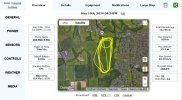Until now I didn't go below 20% of battery level.
After my last flight of my Air 3 I looked at the battery levels. The level was at 20% and the Voltage per cell was at 3.54V while the Air 3 was standing on the ground. So I hovered for a while and watched the cell voltages. It came down to 3.46V per cell until I landed at 16%.
The Air 3 has Li-Ion batteries and these batteries are usually save to drain them to 3.0V. At this voltage they drop quickly. Some datasheets say that you can go down to 2.75V and some batteries even down to 2.5V.
My question is: how low do you go with your batteries? Do you check the Voltage before takeoff and after landing? What is the Voltage under load at 10% or 0%? Please tell your model and battery type.
After my last flight of my Air 3 I looked at the battery levels. The level was at 20% and the Voltage per cell was at 3.54V while the Air 3 was standing on the ground. So I hovered for a while and watched the cell voltages. It came down to 3.46V per cell until I landed at 16%.
The Air 3 has Li-Ion batteries and these batteries are usually save to drain them to 3.0V. At this voltage they drop quickly. Some datasheets say that you can go down to 2.75V and some batteries even down to 2.5V.
My question is: how low do you go with your batteries? Do you check the Voltage before takeoff and after landing? What is the Voltage under load at 10% or 0%? Please tell your model and battery type.











